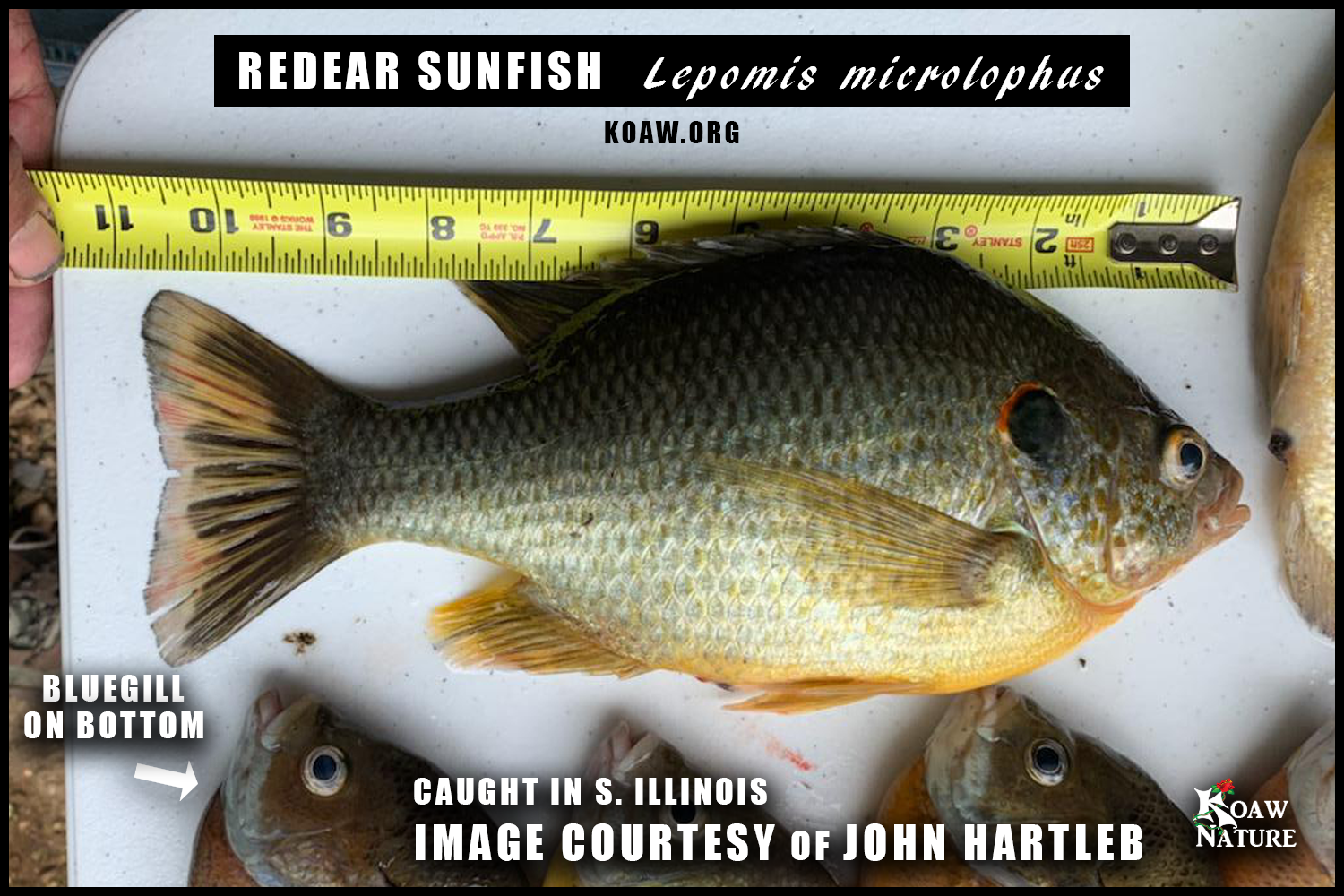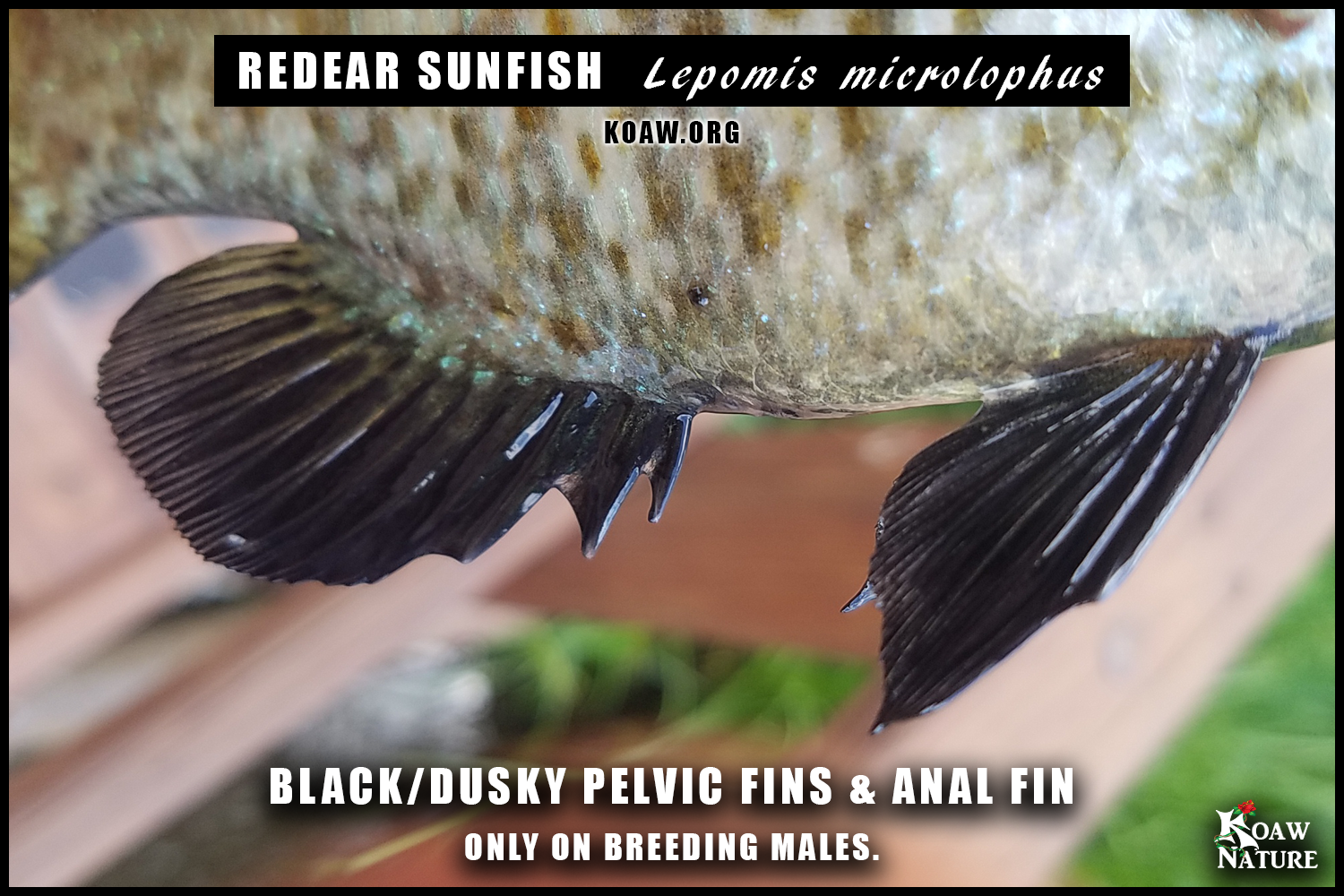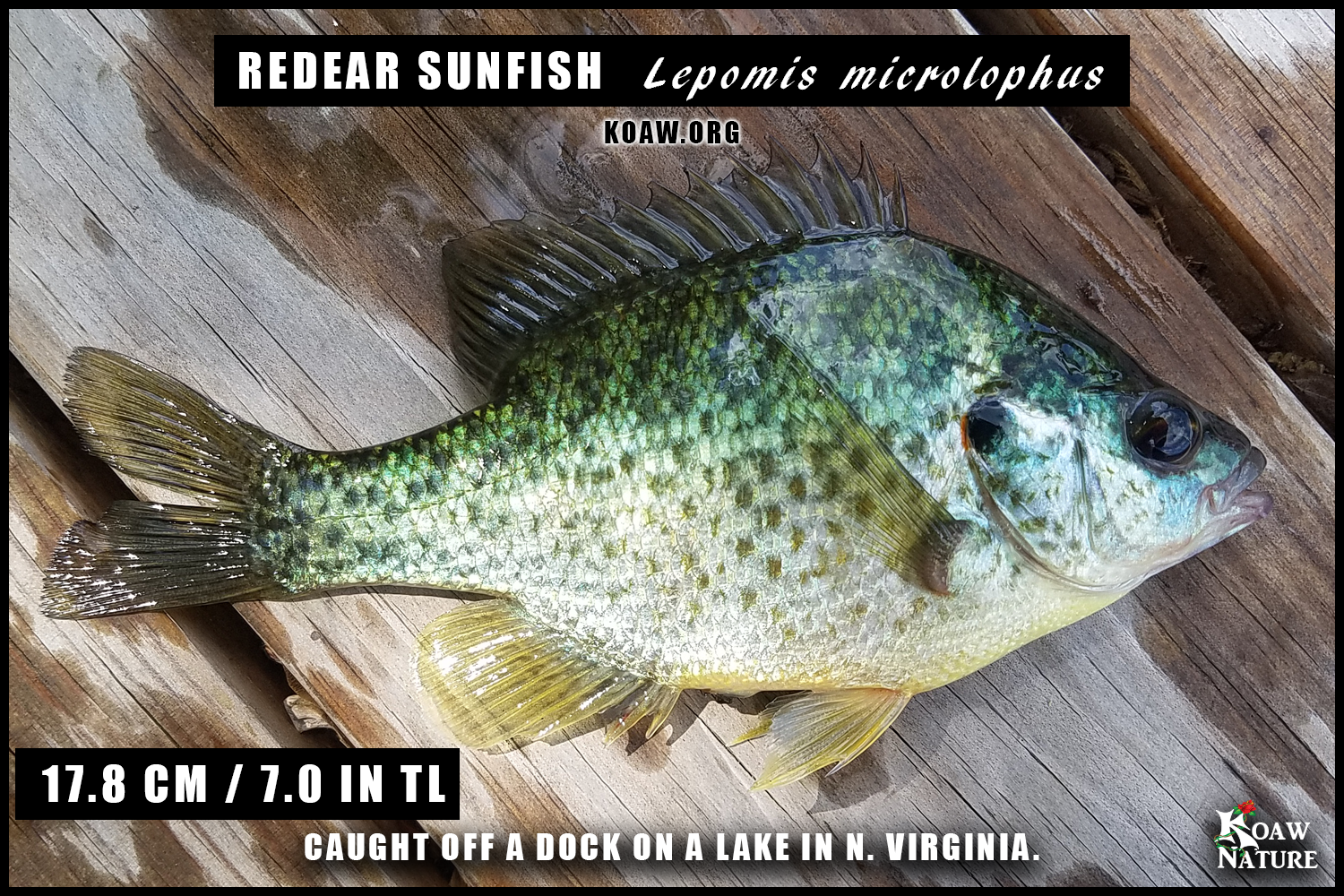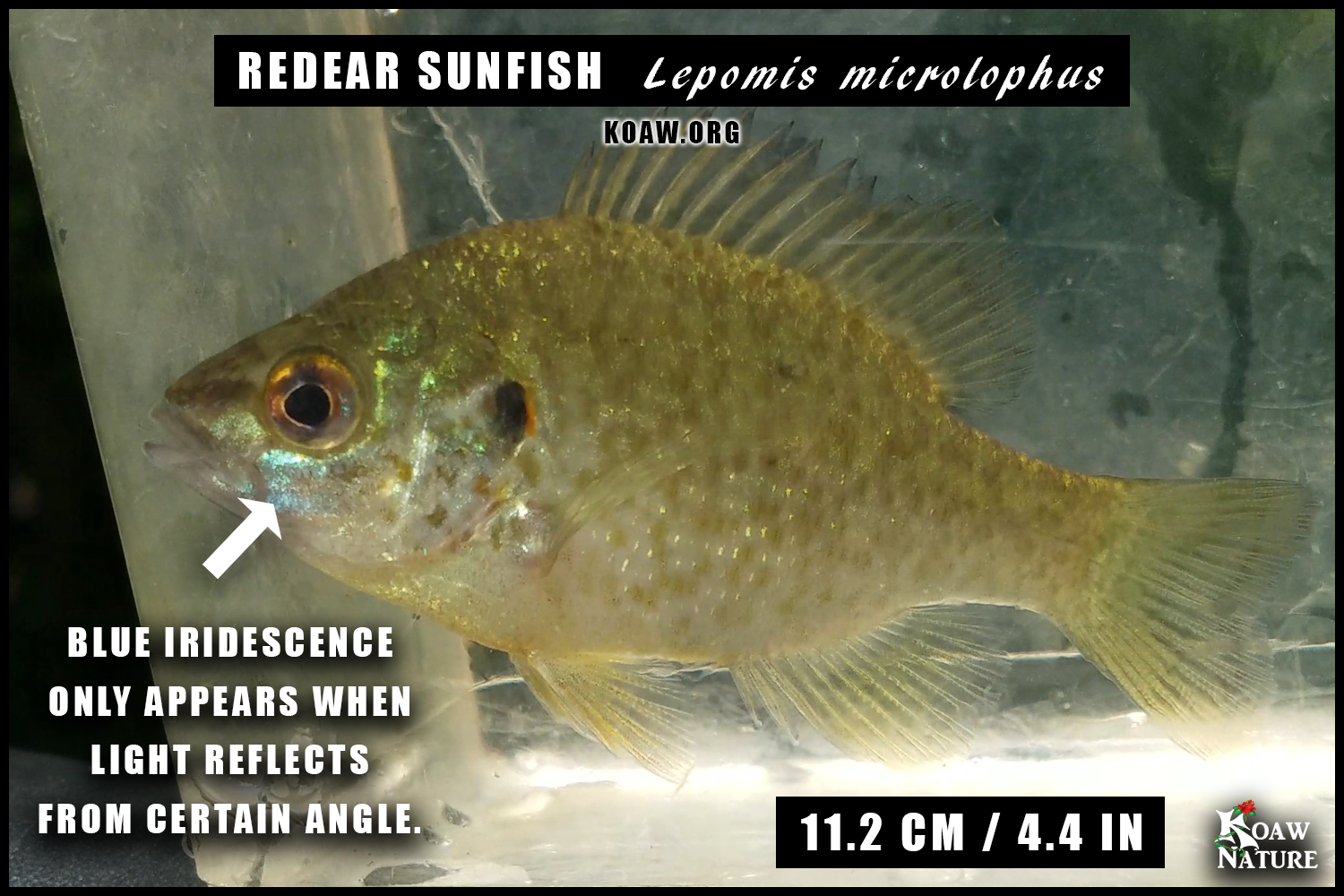By Koaw - November, 2020 (Updated 2022)
GENERAL: : The redear sunfish (Lepomis microlophus – Günther, 1859) is primarily native to the southeastern portions of the United States but also has a very large introduced range.
Great features to examine on the redear sunfish are the bright red spot on the opercular flap with surrounding white edging, the spotting on the cheek/operculum/side of body, as well as the very long and pointy pectoral fin.
The redear sunfish has been known to create hybrid offspring in nature with the following intrageneric species: warmouth (L. gulosus), green sunfish (L. cyanellus) and bluegill (L. macrochirus). [1] In lab settings, the redear sunfish has been successfully hybridized with redbreast sunfish (L. auritus). [2]
Typically 13-14 pectoral rays, 9-10 dorsal spines, 11 dorsal soft rays, and 10-11 anal soft rays.[3][2]
BODY: The redear sunfish has a deep, compressed body like the other sunfishes in Lepomis with a profile very similar to that of the bluegill (Lepomis macrochirus). The lateral line is complete with 34-47 lateral scales. [3]
Click to enlarge.
COLORATION: Often the cheek and operculum have gold/gray/brown spots. The upper body is olive green to gold. Spotting or broken vertical bars of gray, gold, and bronze exist on the lateral sides. Young express barring over spotting. The breast and belly are often white to yellow with minimal markings. The fins are mostly transparent where some mottling may exist on the 2d dorsal fin. [3]
Breeding males will have dark fins and the body will take on a “brassy gold” coloration [3] and may sometimes appear almost mostly black. See the photo of the breeding male I caught in Virginia; the pelvic fins and anal fin appear nearly black.
SIZE: To ~40 cm (16 in). Although Page & Burr report size to 25 cm (10 in) [3] most all state-records report maximums around that of bluegill. Pond specimens, especially those being fed by humans, tend to grow quite large. IGFA All-Tackle World Record: 2.61 kg (5 lb 12 oz) [4] The redear may be able to grow the largest of all the lepomids.
OPERCULAR FLAP: The “ear flap” will have white edging both ventrally and dorsally with a conspicuous red to orange spot on the posterior end. The opercular flap remains short on the redear sunfish.
Males, especially during breeding season, will have the brightest & most conspicuous red spots on the ear flap. The red on females and juveniles will not be as pronounced, and at times, broken.
Hubbs and Lagler suggested that males have a red spot on the opercular flap while females possess an orange spot, [5] though I did not find this sexual dimorphism mentioned in any other text/study. During my survey, I did not sex enough specimens with varying orange and red on the opercular flap to properly test this suggestion.
GILL RAKERS: The gill rakers are short and thick on the first gill arch, often bent. These are easily seen by lifting the gill cover and looking at the white portion above the red filaments on the gill arch closest to the gill cover.
The rakers in the adjacent photo came from a specimen in Illinois; this size is probably the most typical of the longest rakers on redear from the many specimens of my survey. However, I did capture a couple of specimens in Virginia where the longest rakers were extremely short and thick.
I made a video describing how to locate and find these rakers that is hosted on Koaw Nature’s Fishing Smarts YouTube channel.
MOUTH SIZE: The redear sunfish has a fairly small mouth where the jaw does not extend underneath the eye’s pupil. The shape of the snout is rather pointy.
More specifically, the maxilla’s most posterior edge will not exceed the anterior edge of the pupil (as the fish’s mouth is closed or nearly closed.)
PECTORAL FIN: The pectoral fins (one on each lateral side) are long and pointed, usually reaching past the eye if bent forward. Often with 13-14 pectoral rays. [3] [2]
The redear sunfish has the longest pectoral fin of all lepomids. The bluegill (Lepomis macrochirus) and pumpkinseed (Lepomis gibbosus) also have very long pectoral fins.
HABITAT: The redear sunfish does well in variety of habitats including lakes, ponds, swamps and pools of rivers with sandy/muddy bottoms. [3]
Redear often cohabitate with bluegill and even are known to have spawning beds in close proximity with this congeneric species. On a lake in Virginia that I often stay near, during the breeding season it is common to pull redear and bluegill from the same group of nests.
CLICK TO ENLARGE - This distribution map is an illustrated approximation created by Koaw primarily pulling data and information from USGS-NAS, Research Grade observations from iNaturalist and Page & Burr’s Field Guide to Freshwater Fishes.
LOCATION: Native to Atlantic and Gulf drainages including the Mississippi River Basin as well as the Ohio River Basin. [6] 3]
This fish has been introduced to many other locations across the United States and even parts of Northern Mexico. States with introduced populations of redear sunfish include California, Oregon, Nevada, Arizona, Colorado, Nebraska, Iowa, Kansas, Oklahoma, Ohio, Pennsylvania, Virginia, Maryland, and Delaware. [7] [6] [3] Redear have also been documented in New Jersey, Vermont and Rhode Island. [6]
FISHING: Fishing for redear is very similar to fishing for bluegill. Using live bait like worms and leeches will work very well. Flies like spider mimics and various nymphs will do the trick. Soft plastics and small crankbaits will also work.
It’s a bit tricky to just target redear as more than likely other sunfishes (like bluegill) will be cohabitating in that area and be willing to go for the same bait. Redear and bluegill will even share nesting areas so it’s really about finding a body of water with redear and getting your line in the water; you may have to sift through a few bluegill first.
SIMILAR SPECIES: The most common confusion I see with redear sunfish (L. microlophus) is when people are looking at smaller specimens from juveniles, subadults, and small adults, confusing the redear sunfish with pumpkinseed (L. gibbosus). The illustration below shows two fairly small specimens. The quickest feature to examine is to notice if there is obvious blue streaking on the snout. Keep in mind that at a certain angle, it may appear that blue iridescence is on the redear’s snout—the blue streaking on the pumpkinseed is visible from any angle, though may be brighter at different angles.
REFERENCES:
W. F. Childlers, "Hybridization of Four Species of Sunfishes (Centrarchidae)," Bull. Ill. Nat. Hist. Surv., vol. 29, no. 3, 1967.
O. R. Smitherman and E. F. Hester, "Artificial Propogation of Sunfishes, with Meristic Comparisons of Lepmis and Five of Their Hybrids," Transactions of the American Fisheries Society, vol. 91, no. 4, pp. 333-341, 1962.
L. M. Page and B. M. Burr, Peterson Field Guide to Freshwater Fishes, Houghton Mifflin Harcourt Publishing Company, 2011.
IGFA, "IGFA All-Tackle World Records Redear Sunfish Lepomis microlophus," [Online]. Available: https://igfa.org/igfa-world-records-search/?search_type=ScientificName&search_term_1=Lepomis&search_term_2=microlophus. [Accessed August 2020].
C. L. Hubbs and K. F. Lagler, FISHES of the Great Lakes Region: Revised Edition/ Revised by Gerald R. Smith, The University of Michigan Press, 2004.
USGS, "USGA - NAS Lepomis microlophus," [Online]. Available: https://nas.er.usgs.gov/queries/SpeciesAnimatedMap.aspx?SpeciesID=390. [Accessed August 2020].
iNaturalist, "iNaturalist Lepomis microlophus,"[Online]. Available: https://www.inaturalist.org/taxa/85127-Lepomis-microlophus. [Accessed August 2020].



